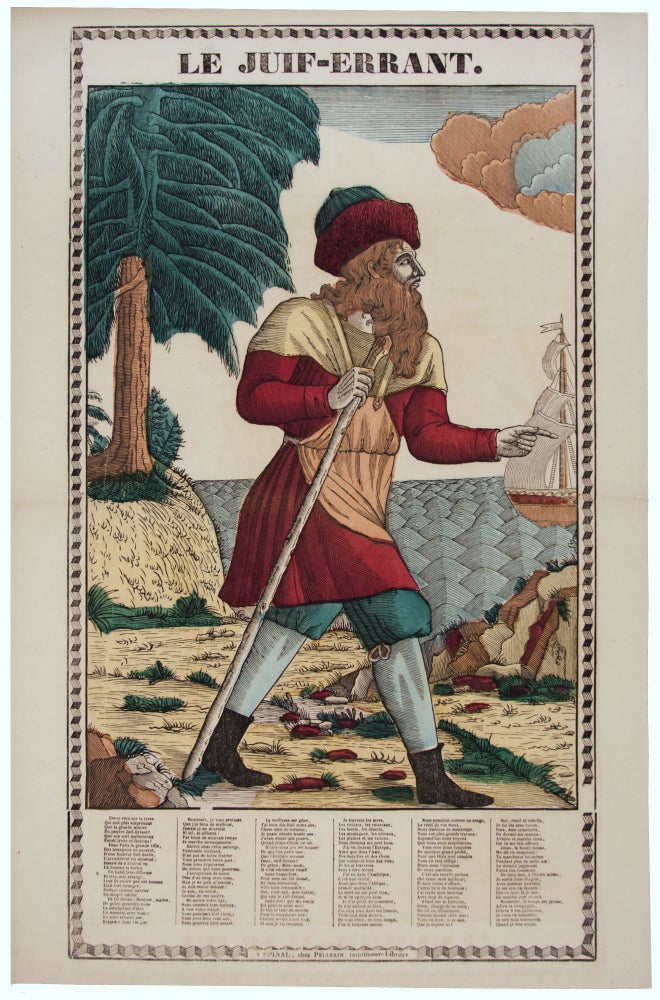
Le Juif-Errant.
Single-sided broadside [64.1 x 41.3 cm], (1) sheet composed of a large woodcut in contemporary handcolor and letterpress text. Colors still fresh vibrant, unobtrusive centerfold, excellent. Rare early 19th-century French popular broadside, here in fine contemporary hand-color, depicting the legendary Juif-Errant, or ‘Wandering Jew,’ the mythical immortal man said to have been present at the Crucifixion who was cursed thereafter to walk the earth ceaselessly until the Second Coming. The broadside has at its center a large woodcut portrait in contemporary hand-color of the Juif-Errant, his long beard and traveler’s walking stick signaling his extreme age and endless itinerancy. A ship in the distance alludes to his travels beyond Europe, to America, Africa and Asia. Surrounding the woodcut are letterpress lyrics to a new popular song about the Jew’s (his name is given here as ‘Isaac Laquedem’) recent encounter with two French bourgeois on the roadside near Brussels. The Wandering Jew legend had its roots in Biblical scripture, but it reappeared with force from the early 13th-century (in Roger of Wendover’s Flores Historiarum, in Matthew Paris, etc.) in parallel with the legend of Joseph of Arimathea: These two still-living (very old) men were bodily present at the Crucifixion, and so their eye-witness testimony certified for later generations the veracity of the Christian religion, offering a real link between Christ and later believers. By the time of this Brussels sighting, just one in a series of supposed encounters with the Wandering Jew (in Vienna in 1599, Lubeck in 1601. Moscow in 1613, Hamburg in 1633, Leipzig in 1642, etc., etc.), the legend had become less about Christian certification and more about the fate of the Jewish people as a whole in a contemporary European context. The present broadside appeared in the 1820s (to judge by other, dated, imprints from the Deckherr press at Montbéliard) and is one of a handful of similar designs apparently inspired by the rise of the “Jewish Question” in the wake of Napoleon’s emancipating reforms of the first decade of the 19th century (lifting ghetto laws, granting citizenship, repealing laws limiting property rights, religious worship and access to certain occupations, etc.). The design of the woodcut of the present Épinal imprint is found (sometimes in reverse) along with the song text in several similar versions from presses in Montbéliard, Nantes, Caen, etc., each of which is rare. OCLC records one U.S. example of this Épinal imprint (JCB). * Champfleury, “Le juif-errant,” Histoire de l’imagerie populaire, pp. 1-81; T. Kselman, Conscious and Conversion: Religious Liberty in Post-Revolutionary France; R. Helot, “Notes sur l’imagerie populaire en Normandie,” Bulletin de la Société Archéologique, Historique & Artistique, vol. 6 (1908), pp. 367-85; F. Maguet, “Le développement du thème du Juif errant dans l’imagerie populaire en France et en Europe,” in J. Braillon-Philippe and L. Golstenne, eds., Le Juif errant: un témoin du temps, pp. 90-107, and 179 (no. 49); G. Milin, Le cordonnier de Jérusalem: la véritable histoire du Juif errant.
Price: $2,450.00
